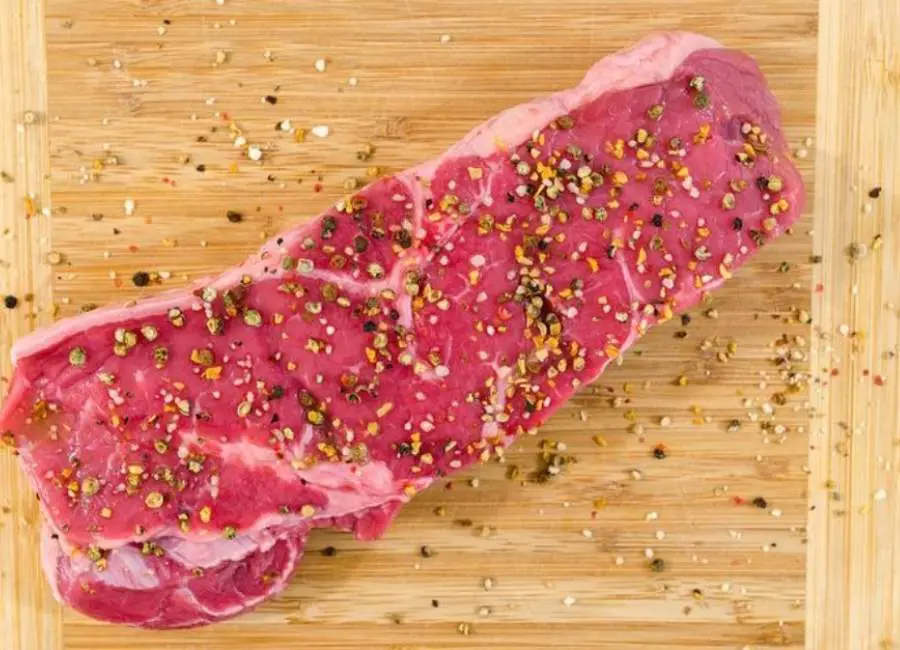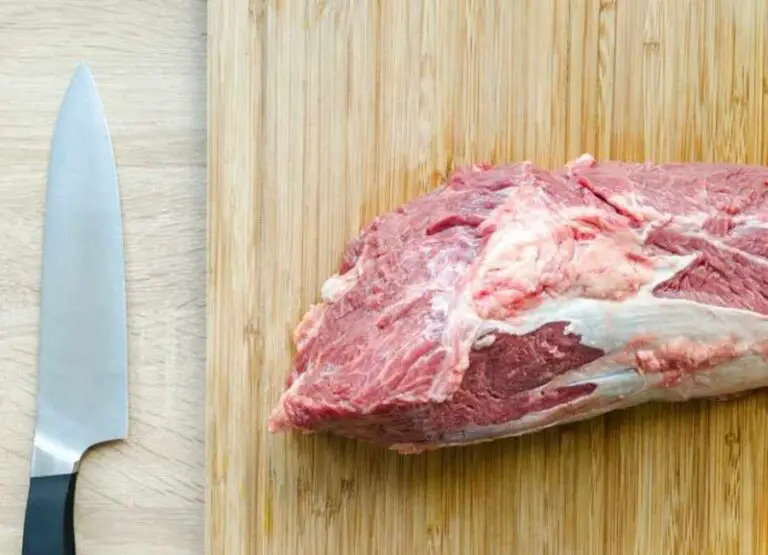Understanding Red Meat Food Poisoning
Hey there foodies! Are you a fan of red meat? Well, you might want to think twice before taking a bite of every red meat.
Red meat food poisoning is a real thing, and it’s not pretty.
In this blog post, we’ll explore the dangers of consuming undercooked red meat and how you can protect yourself from getting sick.
So, grab a seat, and let’s dive in!
What Is Red Meat Food Poisoning
Red meat food poisoning is a general term used to describe foodborne illnesses caused by consuming contaminated red meat, such as beef, lamb, and pork.
The most common types of bacteria that can cause red meat food poisoning are Salmonella, E. coli, and Campylobacter.
It is important to handle and cook red meat properly to reduce the risk of food poisoning.
Causes of Red Meat Food Poisoning
The following are some common causes of red meat food poisoning:
1. Bacteria
Salmonella and Escherichia coli are two bacteria that might be present in raw or undercooked red meat which can cause food poisoning.
These bacteria can produce signs including fever, nausea, vomiting, diarrhea, and abdominal pain.
Red meat must be cooked to the right temperature, which is normally 145 °F (63 °C) for beef and lamb and 160 °F (71 °C) for ground beef, to prevent bacterial infection.
2. Contaminated spices or marinades
While marinades and spices can enhance the flavor of red meat, they can also introduce hazardous bacteria into the food if they are infected.
Use fresh spices and marinades rather than ones that have been lying in your pantry for a while to lower the risk of food poisoning.
Using contaminated spices or marinades in cooking red meat will end up leading to red meat food poisoning.
3. Contamination during slaughter
It’s crucial to handle the animal cautiously during the slaughter procedure to prevent infection.
For instance, the meat may get contaminated with dangerous bacteria if the animal’s intestines are ruptured during the killing process.
Similar to how bacteria on the animal’s skin or hair can get into the meat if it isn’t thoroughly cleaned before processing.
This is why it’s crucial to get meat from reliable vendors who adhere to strict safety and sanitary standards.
4. Cross-contamination during preparation
When bacteria from one food item, such as raw meat, come into touch with another food item, such as vegetables, during preparation, cross-contamination can happen.
This may occur if the same cutting board or knife is not properly cleaned after using it for both meat and vegetables.
Use distinct cutting boards and utensils for raw meat and other meals to avoid cross-contamination, and always thoroughly wash your hands and surfaces with soap and water after handling raw meat.
5. Improper storage
To prevent the growth of dangerous microorganisms that can cause red meat food poisoning in red meat, red meat should be kept at or below 40 °F (4 °C).
Bacteria can quickly multiply and result in food poisoning if meat is stored at a temperature that is too warm or is left out at room temperature for an extended period.
Use meat soon after purchasing it and store it in the freezer or refrigerator to avoid this.
For instance, entire slices of beef can be refrigerated for 3–5 days, but ground beef should be consumed within 1–2 days.
6. Use of contaminated equipment
Cutting boards, knives, and other tools can spread dangerous bacteria to the meat if they are not spotless and sterilized before use.
For this reason, it’s crucial to thoroughly wash all tools and surfaces with soap and water both before and after handling raw meat.
To sanitize surfaces, you can also mix 1 tablespoon of liquid chlorine bleach with 1 gallon of water.
7. Toxins
Red meat can be contaminated by certain toxins generated by bacteria like Clostridium botulinum, which can lead to food poisoning.
When meat is inadequately canned or stored, this can occur.
To avoid this kind of contamination, safe canning and preservation procedures must be followed.
For instance, pressure canning is advised for low-acid items like a meat to stop the growth of microorganisms that cause botulism.
8. Eating undercooked red meat
It’s crucial to cook red meat to a safe internal temperature to eradicate any potentially hazardous microorganisms.
For instance, steaks and roasts should be cooked to an internal temperature of 145 °F (63 °C) with a three-minute rest period, while ground beef should be cooked to an internal temperature of 160 °F (71 °C).
Food poisoning can result from hazardous germs surviving if meat is not cooked to a safe temperature.
Common Symptoms of Red Meat Food Poisoning
Here are some common symptoms of red meat food poisoning:
- Fever: When the body attempts to combat the infection, a fever—a typical sign of food poisoning from red meat—can develop.
- Headache: The body’s reaction to the infection may be the cause of this typical symptom of food poisoning from red meat.
- Fatigue: Fatigue is a common sign of food poisoning from red meat and can develop while the body fights the illness.
- Dehydration: Vomiting and diarrhea can cause dehydration, which can result in symptoms including dry mouth, increased thirst, and decreased urine production.
- Muscle aches: Muscle pain is a less frequent but occasionally seen symptom of food poisoning from red meat.
- Blood in the stool: Blood in the stool is a less frequent sign of food poisoning from red meat, but it can happen in really bad infections.
- Nausea and vomiting: Vomiting and nausea are typical signs of food poisoning from red meat, and they might appear a few hours to a few days after eating tainted meat.
- Diarrhea: Another typical sign of food poisoning from red meat is diarrhea, which can range from moderate to severe.
- Abdominal pain: A common sign of food poisoning from red meat is abdominal pain, which can be brought on by digestive system inflammation or irritation.
Learn more about how much red meat you should eat and if red meat is bad for you.
Prevention of Red Meat Food Poisoning
Here are some common tips:
- Cook meat thoroughly: Make sure to cook red meat to a safe internal temperature to kill any harmful bacteria.
- Store and handle meat properly: Keep red meat refrigerated at or below 40 degrees Fahrenheit, separate raw meats from other foods during storage and preparation, and sanitize any surfaces and utensils that come into contact with raw meat.
- Wash hands and surfaces often: Wash your hands and any surfaces that come into contact with raw meat frequently with hot, soapy water.
- Avoid cross-contamination: Use separate cutting boards, utensils, and plates for raw and cooked meat to avoid cross-contamination.
- Check expiration dates: Make sure to check the expiration date on red meat before purchasing and consuming it.
- Eat fresh and properly stored meat: Consume red meat that is fresh and properly stored to minimize the risk of bacterial growth.
- Monitor symptoms: Be aware of the symptoms of food poisoning, such as diarrhea, stomach pain, nausea, vomiting, and fever, and seek medical attention if necessary.
- Be cautious with high-risk meats: Be extra cautious when handling high-risk meats such as ground beef, and consider cooking them to a higher temperature to be safe.
- Avoid risky behaviors: Avoid risky behaviors that may increase the risk of food poisoning, such as smoking, excessive alcohol consumption, and eating undercooked or raw meat.
Treatment of Red Meat Food Poisoning
Most cases of food poisoning from red meat can be treated at home with rest and hydration.
It is important to replace fluids lost due to diarrhea and vomiting. In severe cases, hospitalization may be necessary for intravenous fluid hydration.
Over-the-counter medications such as anti-diarrheal agents and anti-nausea medications may also provide relief from symptoms.
If symptoms are severe, such as bloody diarrhea, high fever, or vomiting that lasts more than three days, it is recommended to seek medical attention.
Learn more about red meat and constipation.
Conclusion
In conclusion, while red meat can be a delicious and satisfying part of our diets, it’s important to handle and cook it properly to avoid the risk of food poisoning.
By following simple guidelines like washing your hands, using separate cutting boards, and cooking meat to the appropriate temperature, you can enjoy your favorite dishes without putting your health at risk.
So go ahead and indulge in that juicy steak or burger, just make sure to take the necessary precautions to keep yourself and your loved ones safe.
References



![Is Lean Red Meat Bad For You [Answered]](https://foodcreeks.com/wp-content/uploads/2023/03/Is-Lean-Red-Meat-Bad-For-You-768x555.jpg)



![Why Does Red Meat Give Me Diarrhea [Explained]](https://foodcreeks.com/wp-content/uploads/2023/02/Why-Does-Red-Meat-Give-Me-Diarrhea-768x555.jpg)